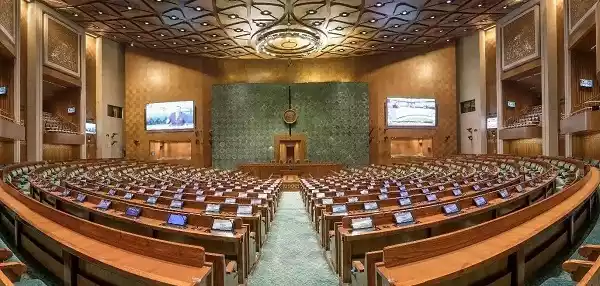PM Modi Inuagurates New Parliament Building, Installs Sengol
New Delhi: Prime Minister Narendra Modi inaugurated the new Parliament building and placed the revered Sengol in the Lok Sabha house. Om Birla, the speaker of the Lok Sabha, greeted Modi as he entered the Parliament building through Gate No. 1 while wearing traditional clothing.
Buy Now: Flipkart | boAt Headphones | Adidas |
The prime minister did ‘Ganapati Homam’ to invoke the Gods to bless the opening of the new Parliament building amid Vedic chants by priests from Karnataka’s Shringeri Math.
With the sacred sceptre in hand, the prime minister bowed before the Sengol and asked for blessings from the high priests of different “adheenams” throughout Tamil Nadu.
Modi then transported the Sengol to the new Parliament building in a procession while ‘nadaswaram’ music played and Vedic mantras were chanted, where he set it in a special enclosure to the right of the Speaker’s chair in the Lok Sabha chamber.
Modi then brought the Sengol to the new Parliament building in a procession while ‘nadaswaram’ music was playing and Vedic mantras were being chanted, and he placed it in a special enclosure on the right side of the Speaker’s chair in the Lok Sabha chamber.

Present at the event were a number of Union ministers, including Rajnath Singh, Amit Shah, S Jaishankar, Ashwini Vaishnaw, Mansukh Mandaviya, and Jitendra Singh, as well as BJP president J P Nadda and chief ministers of Assam and Uttar Pradesh.
The prime minister honoured several workers who were instrumental in creating the new Parliament building by giving them shawls and mementos. An interfaith prayer service was also conducted to commemorate the event. Later, the prime minister visited the historic Parliament House with the Speaker and a few other guests.
The new Parliament building, built by Tata Projects Ltd., would have a regal constitution hall to highlight India’s democratic legacy, an MPs’ lounge, a library, many committee rooms, dining areas and plenty of parking.
The four-story, triangular structure has a built-up area of 64,500 square metres. The Gyan Dwar, Shakti Dwar, and Karma Dwar are the three primary entrances to the structure. There will be several entrances for VIPs, lawmakers, and guests.
The new building’s materials came from diverse locations across the nation. The red and white sandstone for the structure came from Sarmathura in Rajasthan, and the teakwood came from Nagpur in Maharashtra. It was also reported that Sarmathura provided the sandstone for the national capital’s Red Fort and Humayun’s Tomb.
The red granite came from Lakha near Ajmer, the white marble from Ambaji in Rajasthan, and the kesharia green stone was bought in Udaipur.
An official stated, “In a sense, the entire nation came together to build the temple of democracy, thus reflecting the true spirit of Ek Bharat Shreshtha Bharat.”
The furniture in the new building was made in Mumbai, while the steel for the artificial ceilings in the Lok Sabha and Rajya Sabha chambers came from the union territory of Daman and Diu.
The stone ‘jaali’ (lattice) works that decorate the structure came from Rajnagar in Rajasthan and Noida in Uttar Pradesh.
While the Ashok Chakra adorning the huge walls of the Lok Sabha and Rajya Sabha chambers and the exteriors of the parliament building were purchased from Indore in Madhya Pradesh, the materials for the Ashoka Emblem were found from Aurangabad in Maharashtra and Jaipur in Rajasthan.

M-sand, also known as manufactured sand or M-sand, was used to mix the concrete for the new Parliament building in Charkhi Dadri, Haryana. Because it is created by crushing massive, hard stones, such as granite, rather than by dredging river beds, M-Sand is thought to be environmentally beneficial.
Brass works and pre-cast trenches came from Ahmedabad in Gujarat, while the fly ash bricks used in the construction came from Haryana and Uttar Pradesh. 300 Rajya Sabha members and 888 Lok Sabha members can each sit comfortably in the new Parliament building.
A total of 1,280 members can fit in the Lok Sabha chamber during a joint session of both Houses. On December 10, 2020, the prime minister lay the cornerstone for the new Parliament building. The current Parliament building, which is 96 years old, was finished in 1927. The ancient structure was discovered to be unsuitable for modern needs over time.
Resolutions encouraging the government to establish a new Parliament building were adopted by the Lok Sabha and Rajya Sabha.
The Constitution was adopted there while the structure was still standing and functioned as independent India’s first Parliament. The edifice, which used to be known as the Council House, served as the Imperial Legislative Council’s home.
In 1956, the Parliament building added two stories to accommodate the need for more room. In order to highlight India’s 2,500-year history of democratic traditions, the Parliament Museum was added in 2006.
YOU MIGHT ALSO LIKE
Trending Searches Today | PM Modi Inuagurates New Parliament Building, Installs Sengol









